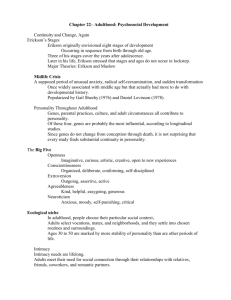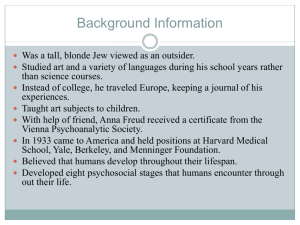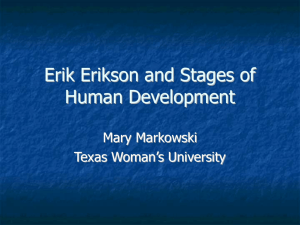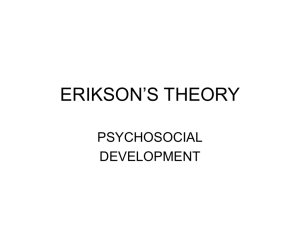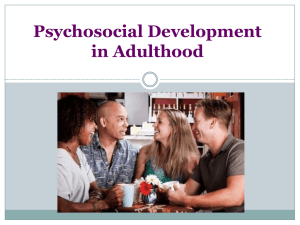– Adulthood: Chapter 22 Psychosocial Development Continuity and Change, Again
advertisement
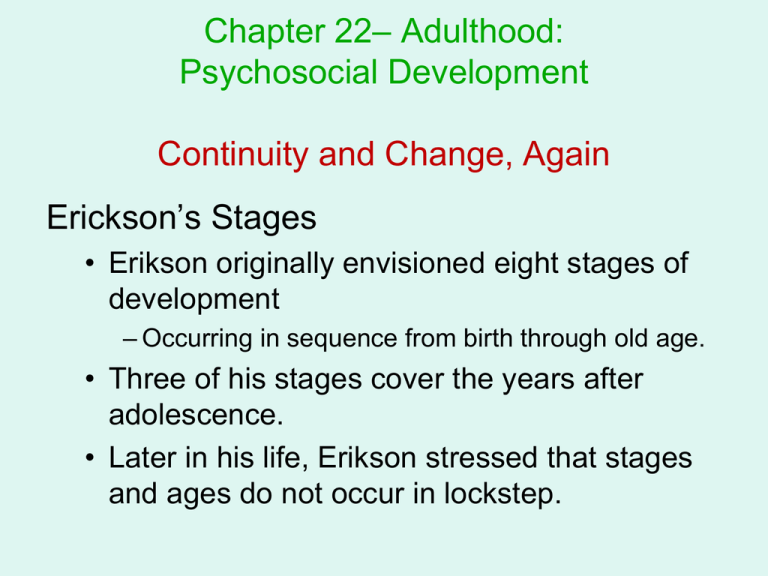
Chapter 22– Adulthood: Psychosocial Development Continuity and Change, Again Erickson’s Stages • Erikson originally envisioned eight stages of development – Occurring in sequence from birth through old age. • Three of his stages cover the years after adolescence. • Later in his life, Erikson stressed that stages and ages do not occur in lockstep. Major Theories: Erikson and Maslow Continuity and Change, Again Maslow’s Stages • Abraham Maslow (1954) described five stages, which occur in sequence. • Movement occurs when people have satisfied their needs at one level and are ready for the next step. • In his later years, Maslow reassessed his final level, self-actualization. • He suggested another level after that, called self-transcendence, not attained till late in life. Major Theories: Erikson and Maslow Midlife Crisis • A supposed period of unusual anxiety, radical self-reexamination, and sudden transformation – Once widely associated with middle age but that actually had more to do with developmental history. – Popularized by Gail Sheehy (1976) and Daniel Levinson (1978). Personality Throughout Adulthood • Genes, parental practices, culture, and adult circumstances all contribute to personality. • Of these four, genes are probably the most influential, according to longitudinal studies. • Since genes do not change from conception through death, it is not surprising that every study finds substantial continuity in personality. Continuity and Change, Again The Big Five • Openness – Imaginative, curious, artistic, creative, open to new experiences • Conscientiousness – Organized, deliberate, conforming, self-disciplined • Extroversion – Outgoing, assertive, active • Agreeableness – Kind, helpful, easygoing, generous • Neuroticism – Anxious, moody, self-punishing, critical Continuity and Change, Again Ecological niche • In adulthood, people choose their particular social context. • Adults select vocations, mates, and neighborhoods, and they settle into chosen routines and surroundings. • Ages 30 to 50 are marked by more stability of personality than are other periods of life. Intimacy • Intimacy needs are lifelong. • Adults meet their need for social connection through their relationships with relatives, friends, coworkers, and romantic partners. • Social convoy – Collectively, the family members, friends, acquaintances, and even strangers who move through life with an individual. Friends and Acquaintances • Friends – The most crucial members of the social convoy – Often able to provide practical help and useful advice when serious problems—death of a family member, personal illness, loss of a job—arise. • Consequential strangers – People who are not close but do have an impact Family Bonds • When family bonds are similar to friendship bonds, relatives are mainstays of the social convoy. • Physical separation does not necessarily weaken family ties. • In fact, relationships between parents and adult children are more likely to deteriorate if they live together. Family Bonds • Over the years of adulthood, parents and adult children typically increase in closeness, forgiveness, and pride as both generations gain maturity. • Familism – The belief that family members should support one another, sacrificing individual freedom and success, if necessary, in order to preserve family unity. Family Bonds • Adult siblings also often become mutually supportive in adulthood. • Adult siblings help one another cope with children, marriage, and elderly relatives. • Sibling bonds are particularly likely to develop during adulthood among children who grew up in large families with major stressors like extreme poverty or a bitter divorce. Family Bonds • Family closeness can sometimes be destructive. • Some adults wisely keep their distance from their blood relatives. • Fictive kin – Someone who is accepted as part of a family to which there is no blood relation – Adults need kin, fictive or otherwise. Committed Partners • Adults everywhere seek committed sexual partnerships to help meet their needs for intimacy as well as to raise children, share resources, and provide care when needed. • Less than 15 percent of U.S. residents marry before age 25, but by age 40, 85 percent have married. • Married people are a little happier, healthier, and richer than never-married ones—but not by much. Committed Partners Empty nest • The time when parents are alone again after their children have moved out and launched their own lives • Contrary to outdated impressions, often improves a relationship. • Most long-married people stay together because they love and trust each other, not simply because they are stuck. Committed Partners Gay and Lesbian Partners • Gay and Lesbian couples have the same issues as straight couples. • Political and cultural contexts for same-sex couples are changing markedly. • Some nations (Spain, etc.) & some states (Iowa, etc.) allow same-sex marriage. • Most nations & 30 states have outlawed same-sex marriages. Divorce and Separation • Adults are affected (for better or for worse) by divorce in ways they never anticipated. • Generally, those in very distressed marriages are happier after divorce, while those in merely distant marriages (most U.S. divorces) are less happy than they thought they would be. • Divorce reduces income, severs friendships, and weakens family ties. Divorce and Separation The Consequences of Divorce • The consequences of divorce last for decades. • Income, family welfare, and self esteem are lower among the formerly married than among people of the same age who are still married or who have always been single. • Almost one out of two marriages ends in divorce in the U.S. Generativity • According to Erikson, after the stage of intimacy vs. isolation comes generativity vs. stagnation, when adults seek to be productive in a caring way. • Adults satisfy their need to be generative in many ways, including creativity, caregiving, and employment. Caregiving • Some caregiving involves meeting another person’s physical needs—feeding, cleaning, and so on—but much of it has to do with fulfilling another person’s psychological needs. • Kinkeeper – A caregiver who takes responsibility for maintaining communication among family members. Caring for Biological Children • The chief form of generativity is establishing and guiding the next generation. • Every parent is tested and transformed by the dynamic experience of raising children. • Just when an adult thinks he or she has mastered the art of parenting, the child advances to the next stage and the adult is required to make major adjustments. Caring for Nonbiological Children • Roughly one-third of all North American adults become stepparents, adoptive parents, or foster parents. • Many adopted or foster children remain attached to their birth parents. • If children are not attached to anyone (ie. after spending years in an institution), they are mistrustful of all adults and fearful of becoming too dependent. Caring for Nonbiological Children Stepfamilies • The average age of new stepchildren is 9 years – They usually they are strongly connected to their biological parents. – This helps the child but hinders the stepparents. • Young stepchildren often get hurt, sick, lost, or disruptive, and teenage stepchildren may get pregnant, drunk, or arrested. • Generativity, with patient, authoritative parenting, is needed. Caring for Nonbiological Children Adoption • Adoptive parents have several advantages: they are legally connected to their children for life, the biological parents are usually absent, and they desperately wanted the child. • Strong bonds can develop, especially when the children are adopted as infants. • During adolescence, these bonds may stretch and loosen as some adoptive children become intensely rebellious. Caring for Aging Parents • Fewer adults are available to care for elderly family members and there are more older adults. • Siblings’ relationships can be strained if a parent becomes frail and needs care. • One sibling usually becomes the chief caregiver. Caring for Aging Parents Sandwich generation • The generation of middle-aged people who are supposedly “squeezed” by the needs of the younger and older members of their families. • In reality, some adults do feel pressured by these obligations, but most are not burdened by them, either because they enjoy fulfilling them or because they choose to take on only some of them or none of them. Employment • The other major avenue for generativity. • Adults have many psychosocial needs that employment can fulfill. • Unemployment is associated with higher rates of child abuse, alcoholism, depression, and many other social problems. Wages and Benefits • Even though average income has doubled, overall happiness within the U.S. has not risen in the past 50 years. • The sense of unfairness is innate and universal, encoded in the brain. In the U.S., many are offended by the extremely high salaries of corporate executives. Working for More Than Money Work meets generativity needs by allowing people to do the following: • Develop and use their personal skills • Express their creative energy • Aid and advise coworkers, as a mentor or friend • Support the education and health of their families • Contribute to the community by providing goods or services Working for More Than Money • Extrinsic rewards of work – The tangible benefits, usually in the form of compensation (e.g., salary, health insurance, pension), that one receives for doing a job • Intrinsic rewards of work – The intangible gratifications (e.g., job satisfaction, self-esteem, pride) that come from within oneself as a result of doing a job Diversity Within the Workplace • Diversity in employees’ backgrounds presents a challenge for employers as well as for workers. • Not everyone has the same expectations, needs, and desires. • Mentor – A skilled and knowledgeable person who advises or guides an inexperienced person. Changing Jobs • One recent change in the labor market that impedes generativity is an increased frequency of hiring and firing. • Between ages 25 and 42, the average U.S. worker has five separate employers. • Older workers find job changes particularly difficult (loss of seniority, lack of new skills, relocation). Variable Schedules • Another recent change in employment patterns is the proliferation of work schedules beyond the traditional 9-to-5, Monday-through-Friday. • Flextime – An arrangement in which work schedules are flexible so that employees can balance personal and occupational responsibilities. Variable Schedules Telecommuting – Working at home and keeping in touch with the office via computer, telephone, and fax. – About one-third of all working couples who have young children and nonstandard schedules save on child care by having one parent at home while the other is at work. Variable Schedules • A major problem is that flextime and telecommuting are less available to those in certain jobs, such as construction. • Part-time work is usually underpaid and offers no benefits. • Shift work often creates sleep deprived people who are often cranky, impatient, and not clear thinkers. Combining Intimacy and Generativity • Job satisfaction depends on the job, the home situation and the worker’s ability to balance intimacy and generativity needs. • Chosen schedules increase worker motivation, happiness, and health. • The midlife crisis, the empty nest, and the sandwich generation are not common.

